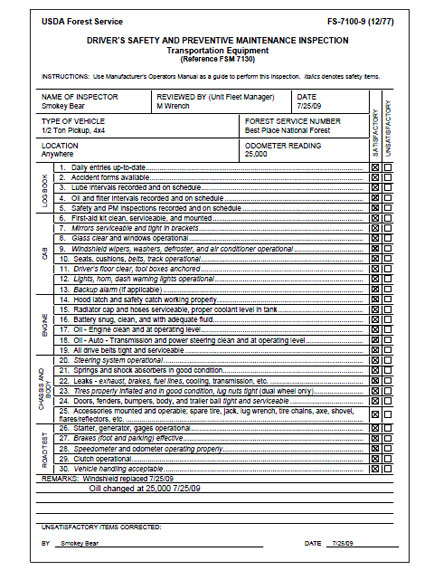Chapter 7—Daily and Monthly Preventive Maintenance Checks
The driver is the single most important factor in preventive maintenance and is responsible for the proper care and use of Government equipment. The driver must take steps to ensure the vehicle is in safe operating condition before each use (EM– 7130–2, Driver-Operator Guide, Preventive Maintenance, p. 13).
Daily Before-Operation Check (also known as the "Circle of Safety")
The driver or operator shall ensure that the vehicle is in mechanically safe condition by visually checking the following items before every use. Any problems with italicized items should be reported to your supervisor or unit, fleet, or maintenance manager immediately for repair.
- Tires— Proper inflation, cuts, breaks, excessive or uneven wear.
- Leaks—Check under the vehicle for any fuel, oil, water, or other leaks.
- Fluids under hood—Oil, transmission, and brake levels are adequate. Fill if low.
- Coolant level in radiator—Adequate. Be sure to fill with the correct type of coolant.
- Lights and signal devices— Operating properly.
- All glass—Clean, free of chips, and unbroken.
- Mirrors— Properly adjusted, clean, and unbroken.
- Fuel supply—Adequate.
- Horn— Operational.
- Brakes— Adjusted and functional.
- Accessories—First aid kit, tire-changing tools, tire chains, etc.
- Steering— Normal free play.
- Equipment logbook—Up to date and properly recorded.
- Battery—Terminals clean.
- Windshield wipers—Operational. Wiper blades in good condition.
- Body—Report dents or other damage before operating a vehicle.
- License plates— Present on the vehicle (one in front, one in rear).

Monthly Preventive Maintenance Inspections
The driver, operator, or individual assigned responsibility for the equipment shall ensure that the monthly inspection is performed and documented. Use the Driver's Safety and Preventive Maintenance Inspection form, FS-7100-9. Other forms may be required for specialized equipment. These forms must be turned in monthly to the fleet management staff (FSH 7109.19, sec. 41.1).
Monthly checks are more thorough than the daily check, so plan on taking 10 to 20 minutes for the monthly inspection. It's a good idea to have a helper if one is available.
After completion, list the items that were checked "repair needed" in the bottom section of the inspection form. Indicate next to the defect the arrangements you have made to get the items repaired. Remember, italics denote a safety item. If an italicized item is checked, the vehicle cannot be operated until repairs are completed.


